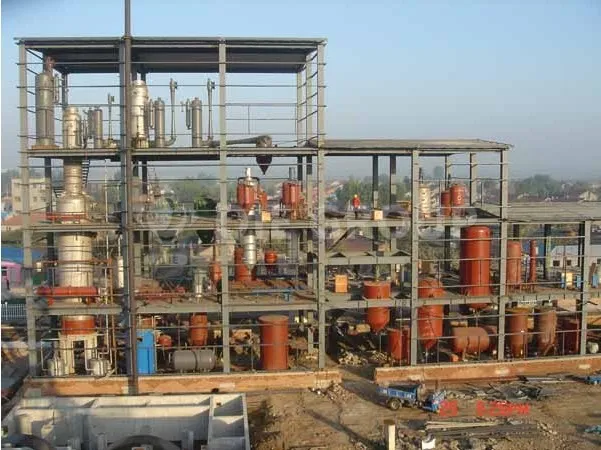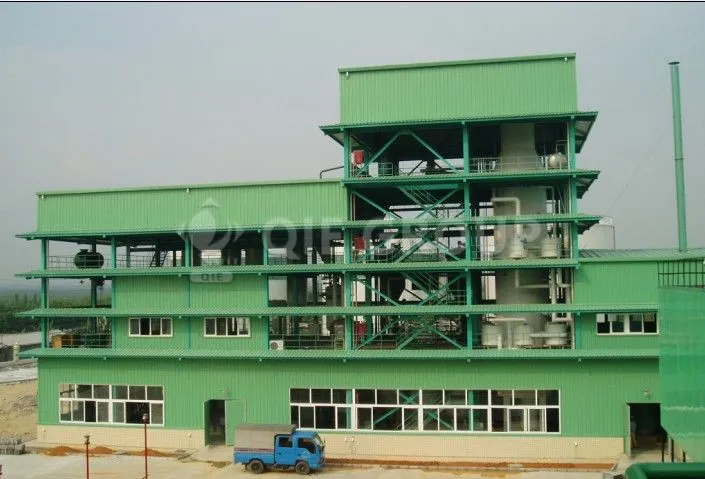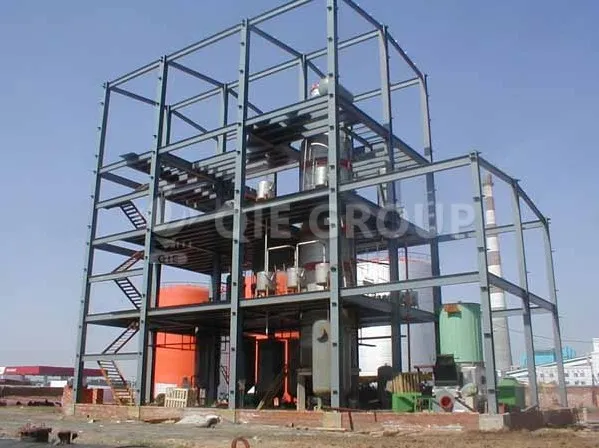
(1) Degumming: The process of removing soluble impurities from crude oil by physical, chemical or physicochemical methods is called degumming. If the lecithin content in edible oil is high, it is easy to foam, smoke and have an odor when heated. In addition, lecithin will turn brown due to oxidation at high temperatures, affecting the flavor of fried foods. Degumming is based on the principle that lecithin and some proteins are soluble in oil in the sewage state, but insoluble in oil after forming hydrates with water. Add hot water or water vapor to the crude oil, heat and stir the oil to 50°C, and then let it stand to separate the water phase, thereby removing lecithin and some proteins.
(2) Deacidification: Free fatty acids affect the stability and flavor of oils and fats and can be removed by neutralizing them with alkali. This is called deacidification, also known as alkali refining.
(3) Decolorization: Crude oil contains pigments such as chlorophyll and carotene. Chlorophyll is a photosensitizer that affects the stability of the oil; other pigments affect the appearance of the oil and can be removed by adsorbents.
(4) Deodorization: There are some unpleasant smelling substances in oils and fats, which mainly come from the oxidation products of oils and fats. The vacuum distillation method is used to add citric acid to chelate excess metal ions and inhibit oxidation.

Hazards of colloidal impurities:
(1) Affect the stability of oils and fats (hygroscopic hydrolysis);
(2) Affecting the refining process (such as causing emulsification, increasing the amount of decolorizing agent, and color reversion after deodorization);
(3) Affecting the use of oil (foaming when heated);
1. Basic principles of hydration degumming
1. Before hydration begins;
Due to the low water content, the phospholipids present an internal salt structure and are completely dissolved in the oil. They will not coagulate or precipitate until the critical temperature is reached.
2. After adding hot water to the oil:
The molecular structure of phospholipids is transformed into a hydrated form, which has a strong ability to absorb water.
Low temperature water replenishment (20-30℃)
Medium temperature hydration (60-65℃)
High temperature hydration (85~95℃)
(1) Critical condensation temperature:
The temperature at which the colloidal dispersed phase in crude oil begins to condense under certain conditions.
(2) Change of critical temperature:
The larger the particle size of the dispersed phase, the higher the critical coagulation temperature. The larger the amount of water added, the larger the particle size, and the higher the critical coagulation temperature.
(3) Process operating temperature:
First determine the operating temperature, then calculate the amount of water to be added based on the colloid content, and then adjust the final temperature based on the hydration and coagulation of the dispersed phase.
Scope of application: soybean oil with high gum content.
Operating conditions: the impurity content of crude oil after filtration is not more than 0.2%, the hydration temperature is 90~95℃, the amount of water added is 3~3.5 times the colloid content of crude oil, the hydration time is 30~40min, the sedimentation separation time is 4h, the drying temperature is not less than 90℃, and the operating absolute pressure is 4.0kPa. If the crude oil is refined and leached, the desolventizing temperature is about 160℃, the operating pressure is not more than 4.0kPa, and the desolventizing time is 1~3h.
B. Preheating: Heat the crude oil to about 80℃
C. Add water for hydration: the amount of water added is 3.5 times the colloid content
D. Settling: After 5-8 hours of heat preservation and settling, the upper clear oil is released, and the flocculent micelles with more oil are left in the hydration tank and mixed with the next batch of crude oil for degumming.
E. Heating, drying and dehydration:
The degummed oil contains 0.3-0.6% water and needs to be vacuum dried at a drying temperature of 100-105°C and a vacuum degree of 680-700 mmHg.
F. Heating, drying and desolventizing:
After the crude oil is degummed, the finished oil needs to remove residual solvents at a temperature of 140°C, a vacuum degree of 680-700 mmHg, a direct steam flow rate of not less than 30 kg/h·t oil, and a desolventizing time of 20-60 min.
G. Hydrating care for oily feet:
Under heating and stirring conditions, add 4% to 5% powdered salt, let it stand to release the bottom brine and skim off the floating oil.
Heat the white paste to 100°C, add 1 to 1.5 times the amount of boiling water and 1.5% fine salt, stir and heat until the paste becomes viscous, let it stand and skim off the floating oil.
2) Medium temperature hydration method
The hydration temperature is 60-65℃. According to the colloid content of crude oil, add 2-3 times of water at the same temperature. The sedimentation time after hydration is not less than 6 hours. The degummed oil is dried, dehydrated or desolventized. It is commonly used for peanut oil degumming.
(3) Low temperature hydration method
The hydration temperature is 20-30℃, and the amount of water added is 0.5 times the colloid content of the crude oil. The sedimentation time is not less than 10 hours. It is only suitable for small enterprises and low-colloid crude oil.

Content: Generally 0.5% to 5%, and can be as high as around 20%.
(1) Crude oil filtration: Filter crude oil containing 0.2% impurities;
(2) Crude oil measurement:
(3) Heating crude oil: to 80-85°C;
(4) Mixing with water: Mix thoroughly with 90°C hot water.
(5) Full reaction: react in the reactor for 40 minutes;
(6) Centrifugal separation: enter the disc centrifuge for separation;
(7) Heating and drying: Heat the degummed oil containing 0.2% to 0.5% water to about 95°C, and then place it in a vacuum dryer for dehydration and drying;
(8) Finished oil cooling: The dried oil enters the cooler and is cooled to 40°C before being transferred to the degummed oil storage tank.






